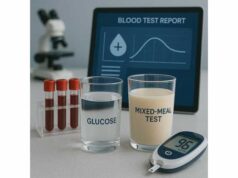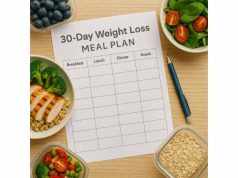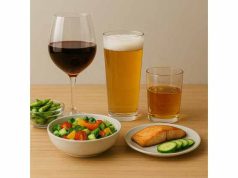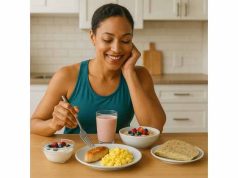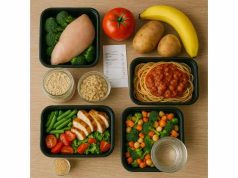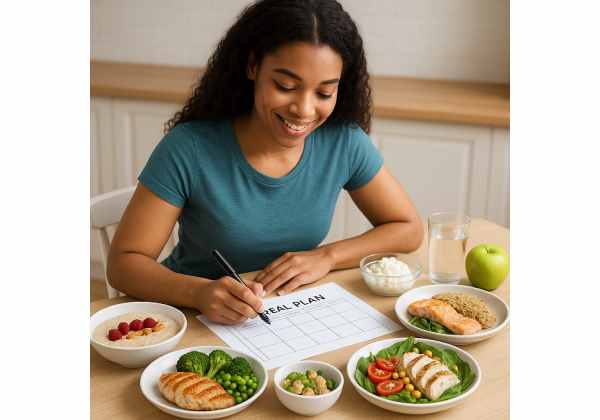
You do not need elaborate recipes to eat well and lose fat. You need a repeatable plan that hits protein, keeps hunger low, and fits a busy week. This seven-day template provides balanced meals at 1500–1800 calories, with built-in swaps for higher activity or rest days. Each day anchors around lean protein, high-fiber carbs, and vegetables so you feel satisfied while staying in a calorie deficit. If you want to revisit how calories, macros, and meal timing work together, skim our concise guide to weight-loss nutrition fundamentals. Then use the step-by-step menu, prep plan, and shopping list below to put it into action tonight.
Table of Contents
- What this 7-day plan does
- Calories and protein targets
- The 7-day menu
- Meal prep and shopping
- Swaps for diet preferences
- Managing hunger and cravings
- Plateaus and progress checks
- Frequently Asked Questions
What this 7-day plan does
A high-protein plan for weight loss should make weekday eating automatic and evening hunger manageable. This one does both. You will eat three meals and one snack most days, each built around protein + fiber + produce. Portions target 1500–1800 calories/day depending on your needs, with simple adjustments noted for each meal.
What to expect
- Steady energy and fewer cravings. Hitting 30–45 g protein per meal slows digestion and helps preserve lean mass while you lose fat.
- Predictable structure. Repeating a handful of breakfasts and lunches reduces decision fatigue and makes portions consistent.
- Flexible dinners. You will rotate quick, family-friendly options so you can stay on track without cooking two separate meals.
How to use the plan
- Pick your daily calorie lane (1500, 1650, or 1800) based on body size, activity, and hunger.
- Follow the 7-day menu as written or mix and match within the week.
- Batch-prep proteins, grains, and vegetables once to save 30–45 minutes on weekdays.
- Measure oils, nuts, and dressings. These small extras are where portions drift.
- Track weight and waist by weekly average, not day-to-day noise.
Who this plan suits
- Adults aiming for gradual fat loss with normal workdays and light to moderate training.
- People who prefer whole foods, simple recipes, and minimal supplements.
- Households that want one dinner everyone can eat, with carb and sauce portions adjusted at the table.
Safety and pacing
A reasonable loss rate is 0.3–1.0% of body weight per week on average. If your schedule, medical conditions, or medication require a tailored approach, talk with a clinician. For an overview of safe pacing and monitoring, see our concise safe weight loss guide.
What this plan is not
- Not a detox, cleanse, or ultra-low-carb challenge.
- Not a “cheat day vs. clean day” cycle.
- Not dependent on special products.
It is a clear template that favors repetition, fast prep, and foods you already know how to cook.
Calories and protein targets
The fastest way to stall is to guess. The fastest way to succeed is to set targets you can repeat. Choose a calorie lane, then let protein and fiber do most of the appetite control.
Pick a calorie lane
- 1500 calories: Often suits smaller or less active adults.
- 1650 calories: A balanced middle ground for many.
- 1800 calories: Useful for taller, heavier, or more active adults, or on training days.
If you are unsure, start at the middle lane, watch your 7-day average weight and waist, and adjust ±100–150 calories after two weeks. For a quick refresher on estimating a daily calorie target, use our guide and plug your number into the menus below.
Set daily protein
- Goal: 0.7–1.0 g per pound of goal body weight (1.6–2.2 g/kg).
- Per meal: 30–45 g at breakfast, lunch, and dinner; 15–25 g at snack.
- Reason: Higher protein improves satiety and helps maintain muscle in a deficit.
Carbs and fats
- Favor high-fiber carbs (oats, potatoes, rice, beans, fruit, whole-grain breads) and measured fats (olive oil, nuts, avocado).
- A workable macro shape across a week is roughly 30–35% protein, 35–40% carbs, 25–30% fat, but you do not need to track every gram if portions are consistent.
Portion cues (no scale required)
- Protein: 1–1.5 palms per meal (about 30–45 g).
- Starchy carbs: 1 cupped hand at lunch and dinner (½ on rest days, 1.5 on hard training days).
- Fats: 1 thumb of oil, nut butter, or nuts per meal (about 5–10 g).
- Vegetables: fill half the plate; fruit is one fist.
Examples by lane
- 1500 calories:
- Breakfast 350, Lunch 450, Snack 150–200, Dinner 500–550.
- Protein 120–140 g/day; fiber 28–35 g/day.
- 1650 calories:
- Breakfast 400, Lunch 500, Snack 200, Dinner 550–600.
- Protein 130–150 g/day; fiber 30–38 g/day.
- 1800 calories:
- Breakfast 450, Lunch 550, Snack 200–250, Dinner 600–650.
- Protein 135–160 g/day; fiber 32–40 g/day.
Adjust the starchy carb and added fat portions to move between lanes while keeping protein steady. On very active days, add one extra cupped hand of cooked carbs to the post-workout meal.
The 7-day menu
Below is a complete week of meals. Each day includes approximate calories (C) and protein (P) per item. Portions shown land near 1650–1700 calories; use the lane adjustments to size up or down. Swap dinners across days if needed.
Lane adjustments
1500: remove one carb portion (½–1 cupped hand) at lunch or dinner or reduce oil/nuts by 10–15 g total.
1800: add one carb portion and 5–10 g fat across the day.
Helpful reference: If you want to substitute different proteins or beans, keep a tab open to our concise protein foods list for quick serving equivalents.
Day 1
- Breakfast: Greek yogurt bowl (250 g 2% yogurt, ½ cup oats, 1 cup berries, 1 tbsp chia). C 430 / P 35
- Lunch: Chicken rice bowl (120–150 g cooked chicken, 1 cup cooked rice, roasted veg, salsa). C 520 / P 40
- Snack: Cottage cheese (200 g) with pineapple (1 cup). C 250 / P 26
- Dinner: Sheet-pan salmon (150 g), potato wedges (250 g cooked), green beans; lemon yogurt sauce (2 tbsp). C 520 / P 40
- Daily: ~1,720 C / ~141 P
- 1500 lane: cut potatoes to 150 g or use 0% yogurt at breakfast.
- 1800 lane: add 1 small whole-grain roll at dinner.
Day 2
- Breakfast: Eggs and toast (2 eggs + 150 g egg whites, spinach, 1 slice whole-grain toast, fruit). C 420 / P 38
- Lunch: Turkey quinoa tabbouleh bowl (150 g turkey, ¾ cup cooked quinoa, cucumber, tomato, parsley, lemon-tahini drizzle 2 tsp). C 520 / P 42
- Snack: Protein shake (25 g whey/soy) + banana. C 260 / P 25
- Dinner: Turkey taco bowls (120–150 g turkey or black beans, ¾ cup rice, lettuce slaw, pico, ¼ avocado). C 520 / P 38
- Daily: ~1,720 C / ~143 P
- 1500: skip avocado or reduce rice to ½ cup.
- 1800: add ½ cup beans to dinner.
Day 3
- Breakfast: Overnight oats (½ cup oats, milk, 200 g skyr, 1 cup strawberries). C 450 / P 36
- Lunch: Lentil pasta salad (75–85 g dry high-protein pasta, 100 g tuna or chickpeas, cherry tomatoes, spinach, light vinaigrette 2 tsp). C 520 / P 35–40
- Snack: Yogurt (170 g) + 15 g granola. C 200 / P 15
- Dinner: Lean beef marinara (120–150 g cooked lean beef or tofu), whole-grain spaghetti (85–100 g dry per adult), side salad. C 600 / P 40
- Daily: ~1,770 C / ~131–136 P
- 1500: reduce pasta by 20 g dry or omit granola.
- 1800: add grated parmesan (15 g) and extra salad olive oil (1 tsp).
Day 4
- Breakfast: Cottage cheese toast (200 g cottage cheese on 2 slices whole-grain toast, tomatoes, 1 tsp olive oil). C 430 / P 35
- Lunch: Stir-fry bowl (shrimp or tofu 150–200 g, 1 cup rice, mixed frozen veg, soy-ginger). C 520 / P 38–42
- Snack: Apple + 1 tbsp peanut butter. C 200 / P 5
- Dinner: Curry (chicken or chickpeas 150–200 g, vegetables, ¾ cup rice). C 580 / P 35–40
- Daily: ~1,730 C / ~113–122 P
- 1500: use ½ cup rice at lunch or dinner.
- 1800: add ⅓ cup edamame to lunch.
Day 5
- Breakfast: Protein oatmeal (½ cup oats cooked in milk; whisk 25 g whey/soy in off heat; 1 banana). C 450 / P 35
- Lunch: Chicken barley bowl (150 g chicken, ¾ cup barley, roasted veg, lemon yogurt sauce 2 tbsp). C 520 / P 40
- Snack: Carrots + hummus (40 g). C 160 / P 5
- Dinner: Baked cod (170 g), potatoes (200 g cooked), peas; 1 tsp butter or olive oil. C 560 / P 40
- Daily: ~1,690 C / ~120 P
- 1500: drop butter/oil at dinner or halve banana.
- 1800: add a small whole-grain roll at lunch.
Day 6
- Breakfast: Savory scramble (2 eggs + 150 g egg whites, peppers, mushrooms; 1 small tortilla). C 430 / P 38
- Lunch: Greek chicken pita (150 g chicken or falafel, whole-grain pita, tomato-cucumber salad, tzatziki 2 tbsp). C 520 / P 35–40
- Snack: Skyr (200 g) + blueberries (1 cup). C 220 / P 22
- Dinner: Stir-fried tofu (200 g) or lean beef (150 g) with rice (¾ cup) and broccoli; sesame 1 tsp. C 580 / P 35–40
- Daily: ~1,750 C / ~130–140 P
- 1500: remove tortilla or reduce rice to ½ cup.
- 1800: add ½ avocado at lunch.
Day 7
- Breakfast: Yogurt parfait (200 g yogurt, ½ cup high-fiber cereal, ¾ cup fruit). C 380 / P 28
- Lunch: Tuna and bean salad (100 g tuna, ¾ cup cannellini beans, greens, light vinaigrette 2 tsp, whole-grain toast). C 520 / P 35
- Snack: Protein shake (25 g) + orange. C 220 / P 25
- Dinner: Roast chicken (150–180 g) or tempeh (200 g), roasted potatoes (200 g), mixed vegetables; gravy or yogurt sauce 2 tbsp. C 620 / P 40
- Daily: ~1,740 C / ~128 P
- 1500: skip toast or reduce potatoes by 80–100 g.
- 1800: add 15 g nuts to the parfait.
Notes and substitutions
- Swap proteins one-for-one by grams cooked. Keep oils measured (1 tsp = ~45 calories).
- Vegetables are “free” up to two cups per meal—dressings and oils still count.
- If mornings are rushed, double a breakfast the night before or use a ready-to-drink protein with fruit.
Meal prep and shopping
A short prep session can save you 30–45 minutes over the next five days and keep portions on target. Here is a compact weekend plan and a streamlined shopping list.
Ninety-minute prep flow
- Start grains and potatoes: Cook a big batch (e.g., 6–8 cups cooked rice, barley, or quinoa; or 1.5–2 kg potatoes).
- Roast a protein: Two sheet pans of chicken thighs/breasts or pressed tofu (1.2–1.5 kg). Season half differently for variety.
- Vegetables, two ways: Roast a tray of mixed veg and chop a raw “salad box” (cabbage, carrots, cucumbers, peppers).
- Make two sauces: Lemon-yogurt-tahini and salsa verde or a soy-ginger mix. Store in jars.
- Portion lunches: Build four bowls for Mon–Thu; keep Friday flexible for leftovers.
- Assemble grab-and-go snacks: Portion yogurt cups, fruit, and hummus into containers.
For a timed weekend sequence you can follow step-by-step, adapt our efficient one-hour meal prep to the menu above.
Smart shopping blueprint (for one adult, one week)
- Protein: 1.2–1.5 kg chicken, fish, tofu, or lean ground meat; 18 eggs; 1–2 big tubs Greek yogurt or skyr; 1–2 blocks cottage cheese; 2–4 cans tuna/beans.
- Carbs: oats, 1–2 kg rice/barley/quinoa, 2–3 kg potatoes, whole-grain bread or tortillas, high-fiber cereal or pasta.
- Produce: 1.5–2.5 kg mixed vegetables (fresh or frozen), salad greens, 1–2 kg fruit (berries, apples, bananas, citrus).
- Flavor and fats: olive oil, tahini, nuts/seeds, salsa, soy sauce, spices, lemons/limes.
- Optional: whey/soy protein powder, skyr singles, high-fiber wraps.
Storage and food safety
- Cooked grains, potatoes, and proteins: 3–4 days refrigerated; freeze extras in single-meal bags.
- Sauces: 4–5 days refrigerated.
- Use clear containers and label portions (e.g., “Lunch, 500 C, 40 P”) to make weekday choices automatic.
Swaps for diet preferences
This plan is flexible. Use the swaps below to keep protein high and calories predictable while accommodating preferences or intolerances.
Vegetarian or vegan
- Protein anchors: tofu, tempeh, seitan, high-protein yogurt (dairy or soy), edamame, lentils, chickpeas, black beans, textured soy protein.
- At breakfast: swap eggs for tofu scramble or soy skyr; add chia or hemp hearts for extra protein and omega-3s.
- At lunch/dinner: double plant proteins (e.g., lentils plus tofu) to reach 35–45 g per meal; keep oils measured.
- For a full week built only from plant proteins, use our vegetarian high-protein plan as a plug-in.
Dairy-free
- Replace Greek yogurt/skyr with soy or coconut-based yogurts that have ≥12 g protein/200 g; use silken tofu in smoothies.
- Choose olive-oil-based sauces (salsa, tahini-lemon, chimichurri) instead of dairy sauces.
Gluten-free
- Use rice, potatoes, quinoa, or corn tortillas in place of bread or pasta; choose certified gluten-free oats and cereal.
Lower-carb days
- Keep protein the same; swap one cupped hand of starch for extra vegetables and a thumb of fats (e.g., olive oil teaspoon or 10 g nuts).
- Choose potatoes or barley on higher-carb days for better satiety per calorie compared with refined options.
Busy week tactics
- Use frozen vegetables (stir-fry blends, peas, spinach) to save washing and chopping.
- Keep shelf-stable tuna, bean pouches, and high-fiber wraps for zero-cook lunches.
Managing hunger and cravings
Hunger is normal during fat loss; unmanaged hunger is what derails plans. Use these levers to feel in control without adding many calories.
Structure meals for satiety
- Protein first: Aim for 30–45 g per meal; add 15–25 g in a snack if evenings are hard.
- Volume foods: Start meals with a big salad or broth-based vegetables. Choose higher-satiety carbs such as potatoes, oats, barley, and beans. See practical ideas in our guide to high-volume foods.
- Order of eating: Vegetables → protein → starch. Many people find this naturally reduces portions.
Tame evenings
- Move more calories earlier in the day if night hunger persists.
- Add a protein + fruit bridge at 4–5 p.m. to smooth the gap to dinner.
- Keep dessert “budget” to 100–200 calories (e.g., Greek yogurt with fruit or a square of dark chocolate).
Hydration and caffeine
- Drink water or tea with meals and between them. 1–2 coffees are fine if they do not disrupt sleep; avoid sugary mixers.
- Use sparkling water or a hot herbal tea as a post-dinner cue that the eating window is closed.
Dining out without derailing
- Follow the plate method: lean protein, vegetables, measured starch.
- Ask for sauces on the side, and decide a drink cap before you order.
- If portions are large, box half when the entrée arrives.
Plateaus and progress checks
Weight loss is not linear. Use data and small adjustments instead of overhauling the plan.
How to measure progress
- Weigh 3–5 mornings per week after the bathroom; track the weekly average.
- Measure waist at the navel once weekly under similar conditions.
- Track adherence: how many meals this week matched the plan within reason? Progress follows consistency.
If results stall for 14 days
- Audit oils and extras. Measure oils, nut butters, dressings, and creamers for one week.
- Increase protein by 10–15 g per meal before cutting carbs.
- Add 20–40 minutes of easy walking on most days.
- Adjust calories by −100 to −150/day if hunger is manageable and the above are in place.
- Sleep 7–8 hours. Poor sleep increases appetite and cravings.
Training day tweaks
- After workouts, add one cupped hand of carbs to the next meal.
- Keep protein steady; do not “earn” ultra-high-fat treats that overshoot the day.
Mindset that helps
- Focus on habits per week, not the perfect day.
- Repeat the same breakfast and lunch Monday to Friday; variety lives at dinner.
- Use a two-week experiment mindset for any change—then reassess with data.
Frequently Asked Questions
How much protein should I eat on 1500–1800 calories?
Most adults do well with 0.7–1.0 g per pound of goal body weight (1.6–2.2 g/kg). In practice, aim for 30–45 g at breakfast, lunch, and dinner, plus 15–25 g in one snack. Keep protein steady while adjusting carbs and fats for your calorie lane.
Can I swap meals between days?
Yes. Treat the week like a toolbox. You can rotate breakfasts and lunches freely and move dinners to nights that suit. Keep the protein anchor and measured fats the same so calories stay in range when you shuffle.
Is 1500 calories too low for me?
It depends on body size, activity, and hunger. If 1500 leaves you exhausted, cold, or preoccupied with food, move to 1650–1800, keep protein high, and monitor your weekly average weight and waist. Sustainable is better than strict.
What if I work out early in the morning?
Have a small carb (banana or toast) before training and a protein-heavy breakfast after. On training days, add one cupped hand of cooked carbs to the post-workout meal and keep hydration consistent.
Can I include dessert or alcohol?
Yes, in planned portions. Keep dessert to 100–200 calories and alcohol to 1–2 drinks, ideally not daily. Balance the day by trimming a small amount of starch or fat elsewhere and prioritizing protein and vegetables at meals.
Do I have to track calories?
Not necessarily. Many people succeed using visual portions (palms, cupped hands, thumbs) and repeating the same meals on weekdays. If progress stalls for two weeks, track for 7–10 days to recalibrate portions, then return to simpler methods.
References
- Enhanced protein intake on maintaining muscle mass, strength, and physical function in adults with overweight/obesity: A systematic review and meta-analysis – PubMed 2024 (Systematic Review)
- International society of sports nutrition position stand: nutritional concerns of the female athlete – PMC 2023 (Guideline)
- Effectiveness of a Per-Meal Protein Prescription and Nutrition Education with versus without Diet Coaching on Dietary Protein Intake and Muscle Health in Middle-Aged Women – PMC 2022 (RCT)
- Cold Food Storage Chart | FoodSafety.gov 2023
Disclaimer
This article provides general nutrition education for healthy adults. It is not a substitute for personalized medical advice, diagnosis, or treatment. If you have diabetes, kidney disease, are pregnant or breastfeeding, take prescription medications, or have a history of disordered eating, consult a qualified clinician before changing your diet.
If this plan helped, please share it with someone who wants clear, doable meals—and follow us on Facebook, X, or whichever network you use for practical weekly menus and coaching tips.

